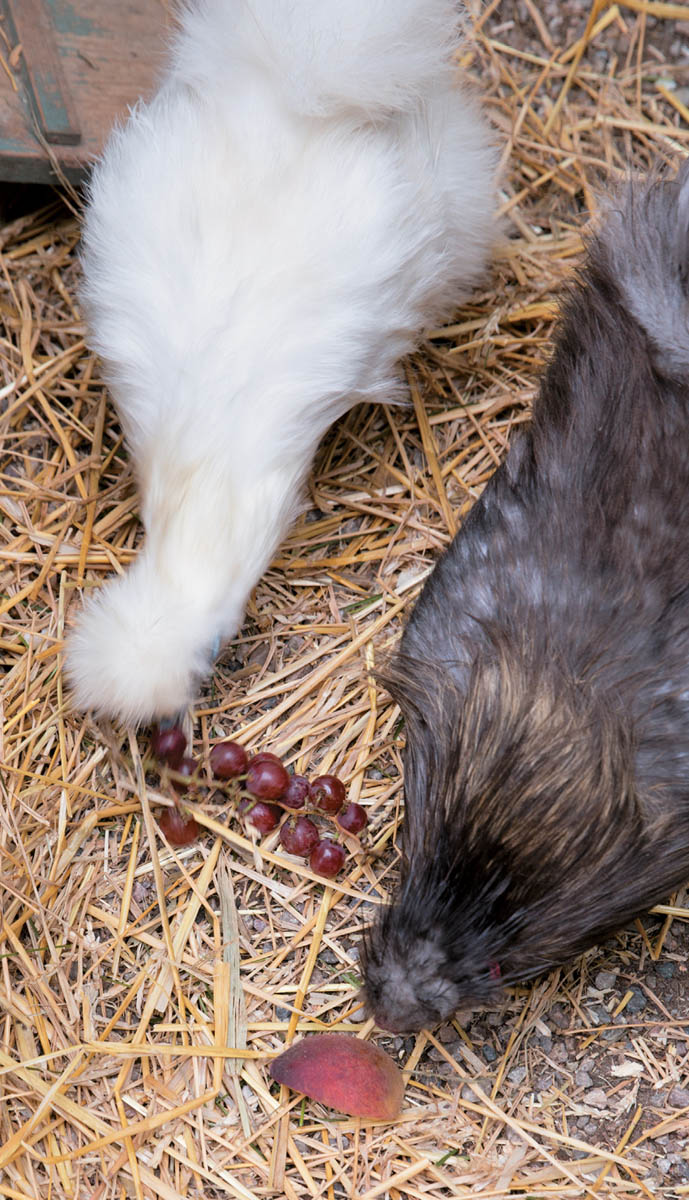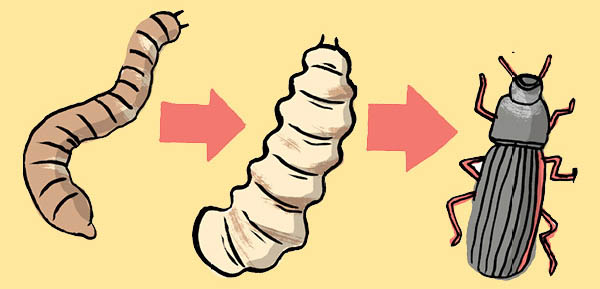
Chickens require age-appropriate food, fresh drinking water, and grit to help with digestion.
As your chickens rapidly grow from day-old chicks into full-size chickens, they will require a variety of chicken feed. Hens older than 20 weeks of age require a calcium source to help them build strong eggshells when they begin laying. And chickens of all ages need grit to make their digestive systems work properly.

From birth to six weeks of age, chicks require a feed formulation known as chick feed. This feed is finely ground for new babies. At around six weeks of age, your chicks will transition to a grower feed. They will remain on this feed until they are approximately 20 weeks of age. After that, the entire flock should be on layer feed that contains at least 16 percent protein. If you decide to keep a rooster or two, they can eat the same diet as the pullets and hens.
Chick feed comes in medicated and non-medicated versions. It isn’t necessary to use medicated chick feed, but it does help to prevent a serious illness called coccidiosis. If you have your chicks vaccinated against coccidiosis (see Coccidiosis), then you should feed them non-medicated feed.
Chicken feed comes in a variety of formulations including mash, crumbles, and pellets. The nutritional value is the same in all three, with usually little to no difference in cost. Some people find that their chickens have a preference. I think that our chickens waste much less food when we use the pellets. Some feel that crumbles or mash are easier to use than pellets if you add supplements or medication.
Transition your six-week-old chicks to the grower feed slowly. At first, they may hesitate to eat something new, just like some kids! If you are using pellets, mix a few in with the chick feed. Over the course of a couple of weeks, you can increase the amount of whole pellets until your chickens are eating only the regular-sized pellets.

If you find that the chicks aren’t eating the whole pellets (sometimes bantams take a while to adjust), have an adult help you crush a few whole pellets into smaller bits, then mix those in with the chick feed and a few whole pellets. Both standard chickens and bantam-sized chickens can eat pellets without any difficulty.

Calcium is essential to the egg-laying process as it makes the eggshells strong and thick. This prevents the eggs from breaking and also helps to curtail egg abnormalities. Chicks under 20 weeks should not be offered calcium, as it can interfere with proper bone development.
Layer chicken feed does contain calcium; however, the amount is usually not enough. So it’s a good idea to provide a dish of calcium separately from the feed and the grit. The hens will ingest the calcium when their bodies require it. Calcium is readily available at feed stores in the form of crushed oyster shells.

You can also feed the chickens’ eggshells back to them. It’s free and fun to recycle eggshells in this manner, and it’s also very simple.
As you use your eggs, rinse out the eggshells and set them aside to dry. When you have a pile of eggshells, place them on a baking sheet and bake at 200°F (93°C) for one hour. This kills off any lingering bacteria such as salmonella.
Remove them from the oven and allow them to cool. Transfer the shells to a sheet of newspaper and crush them into small pieces with a rolling pin.

Crush the shells into tiny pieces so your hens don’t recognize them as eggs. You don’t want them to start eating freshly laid eggs, which is a hard habit to break once it starts.
To digest their food properly, chickens need access to grit, which is coarse sand or tiny gravel that helps to grind up food in their digestive tract.
Grit comes in two sizes: chick-sized grit and grit for older birds. Be sure to provide the proper size grit for the age of your flock.
Provide the grit in a small dish separate from their feed. This way your birds can decide when they need grit. If you free-range your chickens and they have access to dirt, they will naturally ingest grit from the soil as they explore.
We like to incorporate traditional and natural techniques in keeping our flock healthy and thriving. These products are not mandatory, but I believe the ones discussed here can make a difference.
Nonetheless, the bottom line is that if one of your chickens is ill or has a bad infestation of worms, natural treatments alone might not be effective. When in doubt, seek proper medical treatment for your ill bird, including a visit to an avian vet, isolation from the flock, and proper medication. See chapter 8 for more about chicken health care.
Apple cider vinegar, the raw variety. The kind with the “mother” — a natural by-product of the fermentation process — is packed with valuable vitamins and nutrients. It promotes digestive health and acidifies the digestive tract to help prevent harmful bacteria and fungi, such as yeast, from growing.
Try adding 1 tablespoon per gallon of water, but use it only in plastic waterers. Metal waterers will eventually rust. We add vinegar to only one of our two waterers. Look for raw apple cider vinegar with the “mother” at health food stores.
Diatomaceous earth (DE), food grade. This fine powder is made of millions of microscopic fossils with very sharp edges. It is chock-full of minerals. In our experience, it helps keep bugs or insects out of the feed. Some people also believe that it acts as a natural dewormer for the flock.
Try adding 2 percent (by volume) of food-grade DE to your chickens’ feed (for example, for every 3 cups of chicken feed, add approximately 1 tablespoon of DE).
Garlic. Adding garlic to your chickens’ diet can help to keep coop odor down, keep biting insects away, decrease cholesterol in eggs, and act as a natural dewormer. Surprisingly, it doesn’t affect the flavor of the eggs.
You can sprinkle garlic powder on your flock’s feed at a rate of up to 3 percent of the total volume (for example, for every 3 cups of chicken feed, add approximately 11⁄2 tablespoons of garlic powder). You can also add a few cloves of crushed fresh garlic to their drinking water.
Pumpkin seeds. In addition to providing vitamins, some evidence suggests that pumpkin seeds can decrease the worm population in your flock. Cucurbitacin is the active ingredient; it is also found in cucumber seeds and squash seeds.
Vitamins and electrolytes. Vitamins and electrolytes can be very helpful during times of stress, such as shipping, heat stress, molting, severe temperatures, injury, and illness. You can add either a powder or a dissolvable tablet to your flock’s drinking water. We usually add vitamins and electrolytes to one of our waterers at least once per week (not the one with the apple cider vinegar).
Yogurt. Plain unflavored yogurt is a treat that your flock will enjoy. It is full of calcium and probiotics for better digestion. Researchers at the University of Florida have found that giving chickens milk also curtails egg eating. We feed our flock approximately 1 cup per six hens per week, in an old ceramic bowl.
Chickens must have access to fresh clean water at all times. Chicks need special waterers at first. Once the flock gets a bit older, you will find a variety of sizes from one gallon to many gallons. Calculate the size of your waterer based on the size of your flock and how much space you have in the coop.

This waterer is made from a five-gallon beverage dispenser fitted with a nipple dispenser and set on some blocks. This system keeps the water clean and off the ground.
If you have more than four chickens, you may want to offer water in a second spot. I like to keep two waterers for my flock, one in the coop and one outside in the run. With a flock of eight birds, we typically refill our two-gallon waterers twice per week, although that varies depending on the weather. Chickens drink more water during warmer days.
Keep the waterers clean and full. Scrub them out at least once per week with a little bit of distilled white vinegar and a plastic scrub brush that you use only for that job.
Many types of waterers are available, made in both plastic and metal. There are hanging styles and ones that sit on the ground, and even heated ones, which can be handy for long cold winters.

How long have you been keeping chickens?
I started showing chickens with 4-H about three years ago, but we’ve had guinea fowl for over ten. We got started with chickens by chicken-sitting one summer for a friend. The four girls ended up staying permanently!
What do you love about keeping chickens?
I love keeping chickens because they are so very sweet and entertaining.
Do you have a favorite breed and why?
I don’t really have a favorite breed. I think they all have unique personalities and traits; however I am very fond of the Speckled Sussex breed. With their beautiful speckled feathers and friendly personalities, they are a joy to have.
What is your favorite thing about chickens?
I enjoy showing my poultry and answering questions about poultry in general. People seem to enjoy meeting my birds and learning more about them! I also enjoy sitting with my flock and reading a book or sharing a snack with them. (They eat my food, but I don’t eat theirs!)
Do you have any advice for other kids just getting started?
I would recommend researching as much as possible before bringing home chicks or chickens.
Chickens need to get most of their nutrition from chicken feed, but don’t we all love a treat now and then? Well, so do chickens! You can feed them kitchen scraps or buy them special treats such as meal worms, black sunflower seeds, or scratch. Scratch is a mix of cracked, whole, and rolled grains; a handful of it can keep your flock happily entertained pecking and, of course, scratching, but it doesn’t offer complete nutrition.
Too many treats can affect the quality and quantity of egg production as well as the flock’s overall health.

Fresh fruit is a treat that chickens always enjoy.
Chickens are curious and will taste just about anything they think might be edible. They love kitchen scraps, and you can offer them almost anything that you eat yourself.
This includes dairy products (hard cheeses, milk, plain unsweetened yogurt, and cottage cheese); cereal, grains, and bread (unsweetened, whole grain); and most fruits and vegetables.
But some foods aren’t good for them. Don’t feed your flock any of the following:
Chickens love this protein-rich treat, but it can be expensive to buy them. You can purchase mealworm beetles from your local feed store or online. If you find live mealworms at a pet-supply store, you can also let them grow into beetles to start the whole cycle. They can be kind of stinky, so keep them in the basement or outside, weather permitting.
This is just one of many ways to raise mealworms. Learn more online and see what technique works best for you.

Mealworms are actually the larvae of the mealworm beetle. The beetles lay hundreds of eggs and then die. After the worms hatch, they develop to the pupa stage before becoming adults.
Mealworms that are golden brown in color are ready for harvesting. You can pick them out of the habitat one by one, or you can just scoop out a handful and toss them into the run with the chickens.
Bonus: Almost everything in your mealworm habitat is edible for the flock!
